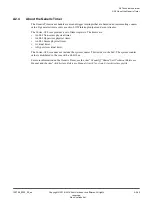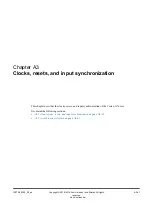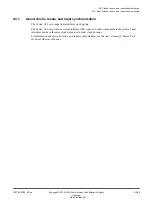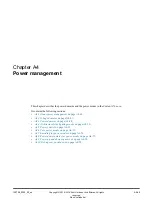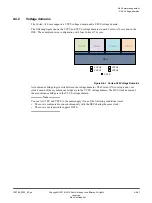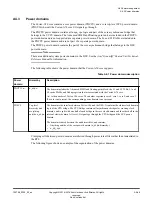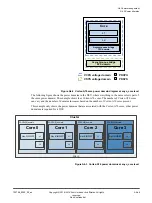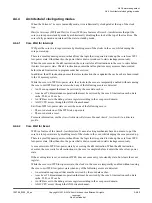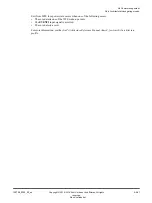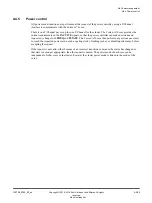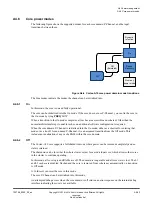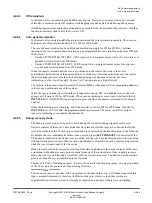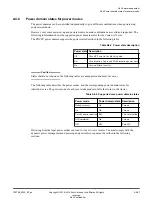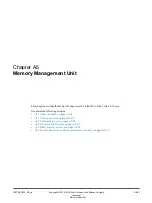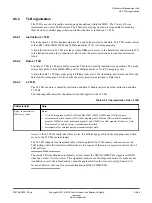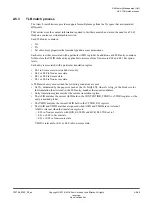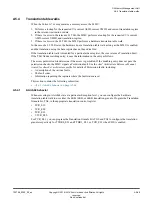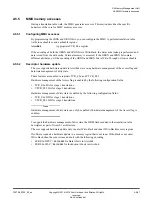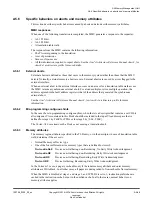
A4.6.3
Off (emulated)
In this mode, all core domain logic and RAMs are kept on. However, core warm reset can be asserted
externally to emulate a power off scenario while keeping core debug state and allowing debug access.
All debug registers must retain their mode and be accessible from the external debug interface. All other
functional interfaces behave as if the core were Off.
A4.6.4
Core dynamic retention
In this mode, all core logic and RAMs are in retention and the core domain is inoperable. The core can
be entered into this power mode when it is in WFI or WFE mode.
The core dynamic retention can be enabled and disabled separately for WFI and WFE by software
running on the core. Separate timeout values can be programmed for entry into this mode from WFI and
WFE mode:
• Use the CPUPWRCTLR.WFI_RET_CTRL register bits to program timeout values for entry into core
dynamic retention mode from WFI mode.
• Use the CPUPWRCTLR.WFE_RET_CTRL register bits to program timeout values for entry into
core dynamic retention mode from WFE mode.
When in dynamic retention and the core is synchronous to the cluster, the clock to the core is
automatically gated outside of the domain. However, if the core is running asynchronous to the cluster,
the system integrator must gate the clock externally during core dynamic retention. For more
information, see the
Arm
®
DynamIQ
™
Shared Unit Configuration and Sign-off Guide
.
The outputs of the domain must be isolated to prevent buffers without power from propagating unknown
values to any operational parts of the system.
When the core is in dynamic retention there is support for Snoop, GIC, and debug access, so the core
appears as if it were in WFI or WFE mode. When such an incoming access occurs, it stalls and the On
PACTIVE
bit is set HIGH. The incoming access proceeds when the domain is returned to On using P-
Channel.
When the incoming access completes, and if the core has not exited WFI or WFE mode, then the On
PACTIVE
bit is set LOW after the programmed retention timeout. The power controller can then
request to reenter the core dynamic retention mode.
A4.6.5
Debug recovery mode
The debug recovery mode can be used to assist debug of external watchdog-triggered reset events.
It allows contents of the core L1 data cache that was present before the reset to be observable after the
reset. The contents of the L1 cache are retained and are not altered on the transition back to the On mode.
By default, the core invalidates its caches when power-on reset (
nCPUPORESET
) is deasserted. If the
P-Channel is initialized to the debug recovery mode, and the core is cycled through power-on reset along
with the system power-on reset, then the cache invalidation is disabled. The cache contents are preserved
when the core is transitioned to the On mode.
Debug recovery mode also supports preserving RAS state, in addition to the cache contents. In this case,
a transition to the debug recovery mode is made from any of the current states. Once in debug recovery
mode, the core is cycled through a warm reset with the system warm reset. The RAS and cache state are
preserved when the core is transitioned to the On mode.
This mode is strictly for debug purposes. It must not be used for functional purposes, as correct operation
of the L1 cache is not guaranteed when entering this mode.
Note
This mode can occur at any time with no guarantee of the state of the core. A P-Channel request of this
type is accepted immediately, therefore its effects on the core, cluster, or the wider system are
unpredictable, and a wider system reset might be required. In particular, if there were outstanding
A4 Power management
A4.6 Core power modes
100798_0300_00_en
Copyright © 2016–2018 Arm Limited or its affiliates. All rights
reserved.
A4-54
Non-Confidential
Summary of Contents for Cortex-A76 Core
Page 4: ......
Page 22: ......
Page 23: ...Part A Functional description ...
Page 24: ......
Page 119: ...Part B Register descriptions ...
Page 120: ......
Page 363: ...Part C Debug descriptions ...
Page 364: ......
Page 401: ...Part D Debug registers ...
Page 402: ......
Page 589: ...Part E Appendices ...
Page 590: ......

